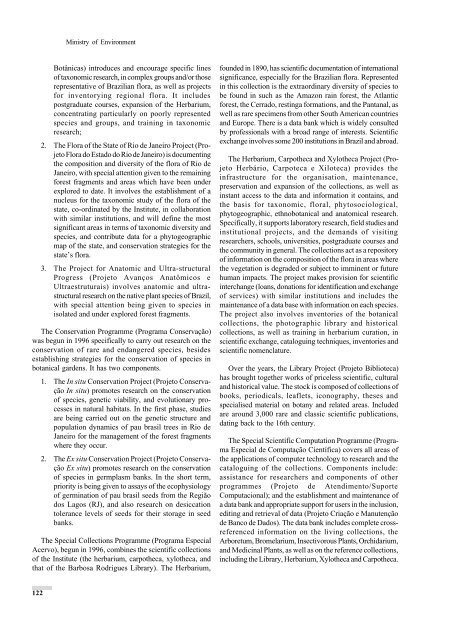Brazil (Part VIII, English version) - Convention on Biological Diversity
Brazil (Part VIII, English version) - Convention on Biological Diversity
Brazil (Part VIII, English version) - Convention on Biological Diversity
- No tags were found...
You also want an ePaper? Increase the reach of your titles
YUMPU automatically turns print PDFs into web optimized ePapers that Google loves.
Ministry of Envir<strong>on</strong>mentBotânicas) introduces and encourage specific linesof tax<strong>on</strong>omic research, in complex groups and/or thoserepresentative of <str<strong>on</strong>g>Brazil</str<strong>on</strong>g>ian flora, as well as projectsfor inventorying regi<strong>on</strong>al flora. It includespostgraduate courses, expansi<strong>on</strong> of the Herbarium,c<strong>on</strong>centrating particularly <strong>on</strong> poorly representedspecies and groups, and training in tax<strong>on</strong>omicresearch;2. The Flora of the State of Rio de Janeiro Project (ProjetoFlora do Estado do Rio de Janeiro) is documentingthe compositi<strong>on</strong> and diversity of the flora of Rio deJaneiro, with special attenti<strong>on</strong> given to the remainingforest fragments and areas which have been underexplored to date. It involves the establishment of anucleus for the tax<strong>on</strong>omic study of the flora of thestate, co-ordinated by the Institute, in collaborati<strong>on</strong>with similar instituti<strong>on</strong>s, and will define the mostsignificant areas in terms of tax<strong>on</strong>omic diversity andspecies, and c<strong>on</strong>tribute data for a phytogeographicmap of the state, and c<strong>on</strong>servati<strong>on</strong> strategies for thestate’s flora.3. The Project for Anatomic and Ultra-structuralProgress (Projeto Avanços Anatômicos eUltraestruturais) involves anatomic and ultrastructuralresearch <strong>on</strong> the native plant species of <str<strong>on</strong>g>Brazil</str<strong>on</strong>g>,with special attenti<strong>on</strong> being given to species inisolated and under explored forest fragments.The C<strong>on</strong>servati<strong>on</strong> Programme (Programa C<strong>on</strong>servação)was begun in 1996 specifically to carry out research <strong>on</strong> thec<strong>on</strong>servati<strong>on</strong> of rare and endangered species, besidesestablishing strategies for the c<strong>on</strong>servati<strong>on</strong> of species inbotanical gardens. It has two comp<strong>on</strong>ents.1. The In situ C<strong>on</strong>servati<strong>on</strong> Project (Projeto C<strong>on</strong>servaçãoIn situ) promotes research <strong>on</strong> the c<strong>on</strong>servati<strong>on</strong>of species, genetic viability, and evoluti<strong>on</strong>ary processesin natural habitats. In the first phase, studiesare being carried out <strong>on</strong> the genetic structure andpopulati<strong>on</strong> dynamics of pau brasil trees in Rio deJaneiro for the management of the forest fragmentswhere they occur.2. The Ex situ C<strong>on</strong>servati<strong>on</strong> Project (Projeto C<strong>on</strong>servaçãoEx situ) promotes research <strong>on</strong> the c<strong>on</strong>servati<strong>on</strong>of species in germplasm banks. In the short term,priority is being given to assays of the ecophysiologyof germinati<strong>on</strong> of pau brasil seeds from the Regiãodos Lagos (RJ), and also research <strong>on</strong> desiccati<strong>on</strong>tolerance levels of seeds for their storage in seedbanks.The Special Collecti<strong>on</strong>s Programme (Programa EspecialAcervo), begun in 1996, combines the scientific collecti<strong>on</strong>sof the Institute (the herbarium, carpotheca, xylotheca, andthat of the Barbosa Rodrigues Library). The Herbarium,founded in 1890, has scientific documentati<strong>on</strong> of internati<strong>on</strong>alsignificance, especially for the <str<strong>on</strong>g>Brazil</str<strong>on</strong>g>ian flora. Representedin this collecti<strong>on</strong> is the extraordinary diversity of species tobe found in such as the Amaz<strong>on</strong> rain forest, the Atlanticforest, the Cerrado, restinga formati<strong>on</strong>s, and the Pantanal, aswell as rare specimens from other South American countriesand Europe. There is a data bank which is widely c<strong>on</strong>sultedby professi<strong>on</strong>als with a broad range of interests. Scientificexchange involves some 200 instituti<strong>on</strong>s in <str<strong>on</strong>g>Brazil</str<strong>on</strong>g> and abroad.The Herbarium, Carpotheca and Xylotheca Project (ProjetoHerbário, Carpoteca e Xiloteca) provides theinfrastructure for the organisati<strong>on</strong>, maintenance,preservati<strong>on</strong> and expansi<strong>on</strong> of the collecti<strong>on</strong>s, as well asinstant access to the data and informati<strong>on</strong> it c<strong>on</strong>tains, andthe basis for tax<strong>on</strong>omic, floral, phytosociological,phytogeographic, ethnobotanical and anatomical research.Specifically, it supports laboratory research, field studies andinstituti<strong>on</strong>al projects, and the demands of visitingresearchers, schools, universities, postgraduate courses andthe community in general. The collecti<strong>on</strong>s act as a repositoryof informati<strong>on</strong> <strong>on</strong> the compositi<strong>on</strong> of the flora in areas wherethe vegetati<strong>on</strong> is degraded or subject to imminent or futurehuman impacts. The project makes provisi<strong>on</strong> for scientificinterchange (loans, d<strong>on</strong>ati<strong>on</strong>s for identificati<strong>on</strong> and exchangeof services) with similar instituti<strong>on</strong>s and includes themaintenance of a data base with informati<strong>on</strong> <strong>on</strong> each species.The project also involves inventories of the botanicalcollecti<strong>on</strong>s, the photographic library and historicalcollecti<strong>on</strong>s, as well as training in herbarium curati<strong>on</strong>, inscientific exchange, cataloguing techniques, inventories andscientific nomenclature.Over the years, the Library Project (Projeto Biblioteca)has brought together works of priceless scientific, culturaland historical value. The stock is composed of collecti<strong>on</strong>s ofbooks, periodicals, leaflets, ic<strong>on</strong>ography, theses andspecialised material <strong>on</strong> botany and related areas. Includedare around 3,000 rare and classic scientific publicati<strong>on</strong>s,dating back to the 16th century.The Special Scientific Computati<strong>on</strong> Programme (ProgramaEspecial de Computação Científica) covers all areas ofthe applicati<strong>on</strong>s of computer technology to research and thecataloguing of the collecti<strong>on</strong>s. Comp<strong>on</strong>ents include:assistance for researchers and comp<strong>on</strong>ents of otherprogrammes (Projeto de Atendimento/SuporteComputaci<strong>on</strong>al); and the establishment and maintenance ofa data bank and appropriate support for users in the inclusi<strong>on</strong>,editing and retrieval of data (Projeto Criação e Manutençãode Banco de Dados). The data bank includes complete crossreferencedinformati<strong>on</strong> <strong>on</strong> the living collecti<strong>on</strong>s, theArboretum, Bromelarium, Insectivorous Plants, Orchidarium,and Medicinal Plants, as well as <strong>on</strong> the reference collecti<strong>on</strong>s,including the Library, Herbarium, Xylotheca and Carpotheca.122
















